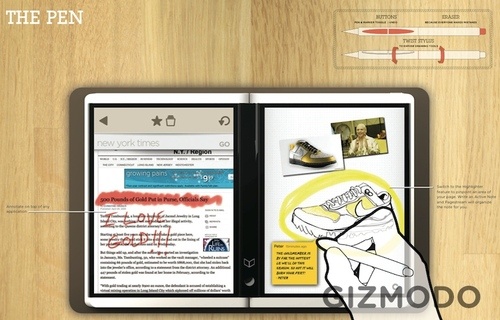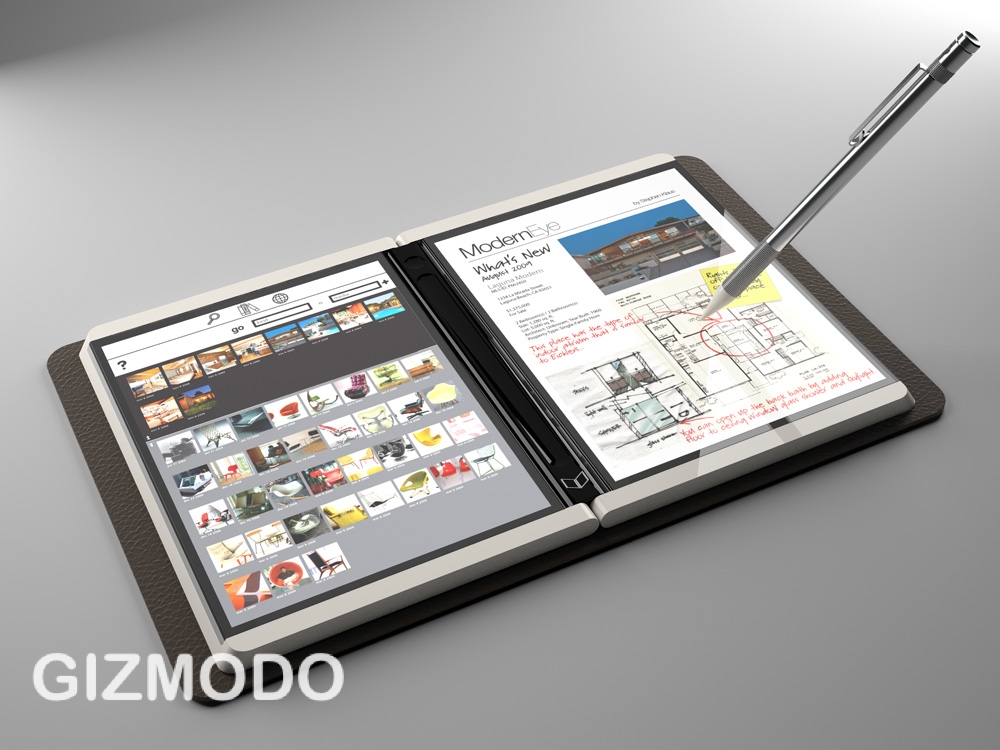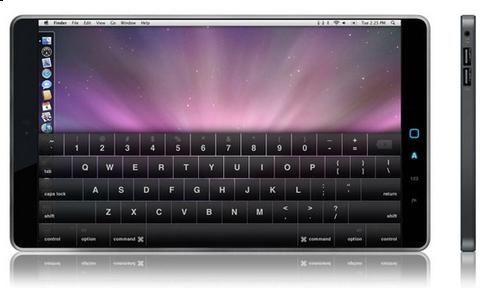
The Lenovo Skylight is being billed as a “smartbook,” positioning itself in the yet to be exploited niche between a netbook and a laptop. The internals are the most intriguing, so let’s start there. It’s the first ARM-based smartbook based on Qualcomm’s 1GHz Snapdragon processor and it packs a 10.1 inch (1,280 x 720) display, 20GB of Flash storage, 2GB of cloud storage, an 8GB miniSD card, a 3.1 megapixel webcam, WiFi, and two USB ports. It also features an AT&T WWAN module, allowing you to connect to AT&T’s 3G service for internet access on the go. Keep in mind you must purchase an AT&T DataConnect plan in order to enable this feature. The impressive internal battery lasts up to ten hours on one charge. The Skylight has a very sleek, minimal design; it weighs under two pounds and it’s about the same thickness as a standard smartphone. When you open the no-frills clamshell lid you find the HD display, a full-sized keyboard, and an integrated USB stick. There’s a designated slot where the included USB stick can be stored when it’s not in use. On the software end, the Skylight runs a customized version of Linux that is based around “live web gadgets.” These gadgets include customizable windows for Facebook, Twitter, Gmail, and YouTube that are constantly updating in front of you. You maybe changing your Facebook status as your live Twitter feed and Gmail account updates themselveswith a YouTube video running in the background. There’s no need to continually log in or refresh. And don’t fret–there’s a standard web browser to surf the Internet the way you’re used to doing it. The OS comes with over 18 pre-installed web gadgets including Amazon MP3 and Roxio CinemaNow, to purchase and download music and movies, respectively. The Skylight will be available for purchase this April for $499 at Lenovo, AT&T, and AT&T stores. There’s no word as to whether or not AT&T will sell it at a subsidized price if you were to purchase their two-year Data Connect plan at time of purchase. Look after the break for a Lenovo product tour video.

Next up is the Lenovo IdeaPad U1 Hybrid. Lenovo is marketing it as the industry’s “first hybrid notebook” giving users the ability to switch from a normal laptop setup to a slate tablet. Allow me to explain. The Hybrid contains two PC form factors in a single device. What’s interesting here is that each form factor has its own processor, operating system, and storage. At first glance, the Hybrid is a 3.8 pound traditional clamshell laptop an 11.6 inch LED (1366 x 768) screen, a full-sized keyboard, runs Windows 7, and is powered by a CULV Intel Core 2 Duo processor. You guessed it–the second form factor is the detachabledisplay. The display doubles as a 1.6 pound multitouch slate tablet with its own Snapdragon processor and customized “Skylight operating system” as found in the Skylight smartbook. Other specs include up to 4GB of RAM (512MB in tablet mode), two USB ports, eSATA, VGA, HDMI, 4-in-1 memory card reader, and a 1.3 megapixel webcam. The laptop can be equipped with a 128GB solid-state drive, with 16GB allotted to the tablet. Like the Skylight it also includes WiFi + 3G Internet connectivity. The battery can support up to five hours of 3G web browsing and six hours when 3G is switched off and in tablet mode. Also neat is that the two form factors are always synchronized; for example, if you are browsing the Internet in laptop mode and detach the display your content seamlessly transfers to the Skylight OS without interuption. The two also share “battery power, 3G wireless, data and documents.” The Skylight software features a “Me Centric” user interface with a four or six section screen display option allowing you to easily access websites, calenders, and other apps while in landscape or portrait mode. Lenovo plans to release the IdeaPad U1 Hybrid on June 1 for $999. Again, no word on a 3G carrier subsidy price.
Normally I do not report on every PC/laptop/netbook release that comes my way. I deemed it poignant to share Lenovo’s smartbook and laptop/tablet hybrid machines because they radiate innovation. The Skylight has a distinctly small, light, and no-frills design and packs impressive internal specs and battery life. It’s customized operating system is unique in that it’s optimized for the web experience from top to bottom. The IdeaPad U1 Hybrid is a fresh concept that I’m frankly surprised to see actually coming to the market. Though it poses as a sleek and lightweight notebook, its detachable multitouch screen that runs the Skylight OS is very intriguing. Such a wild idea may result in the long sought solution to helping the slate tablet find its niche in PC market. No matter how these new entrants in the young smartbook and new hybrid categories sell once they’re released I have a strong feeling their unique form factors and intentions will reverberate throughout the industry as effective product designs.
[Via Engadget, here & here; LaptopMag]
Continue reading Lenovo shows off Skylight & Hybrid innovations
































































